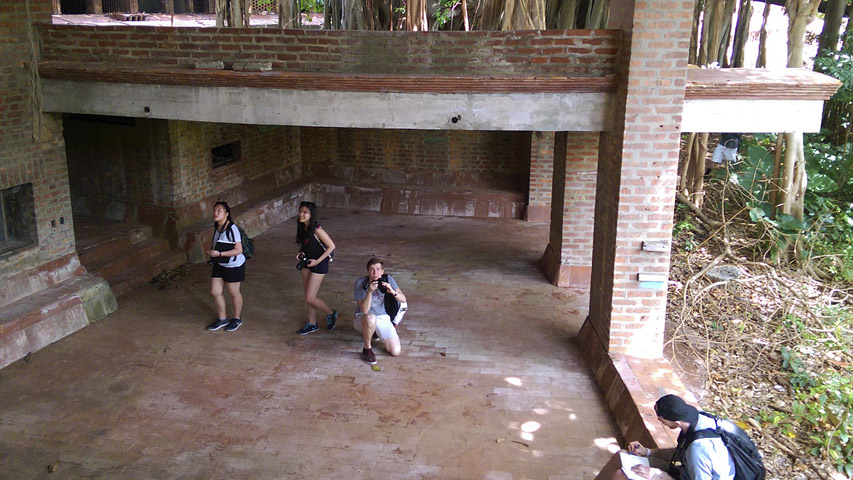Work of Art
Students, Faculty Visit Cuba To Study Redevelopment of Historic School

Students explore the interior of the School of Music building, which is part of Cuba's National Arts Schools.
While Cuba and the U.S. are renewing relations, Carnegie Mellon University faculty and students are working on a revival.
Cuba's National Arts Schools, known as the Instituto Superior de Arte, was conceived in 1960 by Fidel Castro and Che Guevara after the Cuban Revolution. The campus, which was to include five new schools on the grounds of the former Havana Country Club, was created to support and nurture Cuban artists and performers in drama, art, music, ballet and modern dance. But it never came to full fruition.
Today while the largely completed schools of art and modern dance are in use, the other half-finished architectural masterpieces have been partially left to ruin. The school was recently named to the World Monuments Fund's Watch List, a compilation of 50 sites in 36 countries at risk due to social and environmental forces.
After meeting with CMU alumna Norma Barbacci, the World Monuments Fund program director for Latin America, Spain and Portugal, Hal Hayes, an alumnus and professor of architecture, recognized the opportunity for CMU students and for Cuba.
"The site is incredibly unique and precious, and this is a rare moment in the history of Cuba. The richness of the site, complexity of the structures, the high standards of the existing academic programs even in difficult physical conditions, and the social and political upheaval going on outside are a tremendous stimulus to the students' engagement, creativity and learning," Hayes said.
Hayes spearheaded a trip to Cuba for 12 students in the Theater Architecture course, a collaborative offering among the College of Fine Arts' (CFA) schools of Architecture and Drama and Master of Arts Management Program, offered jointly through CFA and the H. John Heinz III College.
Faculty members joining Hayes on the trip were Dick Block, professor and associate head of the School of Drama, and Kathryn Heidemann, assistant dean for initiatives of the Heinz College and CFA.
During the weeklong visit, which took place one week before President Barack Obama's historic arrival, class members conducted a site analysis of Cuba's arts schools, interviewed administrators, faculty, students and visiting artists, and explored examples of Havana's 500-year history of architecture and urbanism.
"There is a real feeling of a moving upward and forward, and there's a lot of anticipation of what is to come," Block said.
An exhibit, "[in]COMPLETION: [in]TRANSITION: The Redevelopment of Cuba's Landmark National Arts Schools," documents the group's journey and will be on display until Aug. 28 at the Future Tenant gallery, 819 Penn Ave. in Pittsburgh. A closing reception will be held at the gallery Aug. 31.
The students investigated how the school buildings could be preserved and reused, and developed design solutions to preserve, renovate and add to the complex to maintain the site's character, fully support the academic and performance programs of the schools, and to expand their outreach into the surrounding neighborhoods.
One of the most interesting challenges was to understand the unique Catalan vault roof structures that all five of the schools used, an example of which can be seen in the monumental stair in CMU's Baker Hall. The original architects of the schools decided on this type of structure because of the shortage of steel, concrete and other building materials due to the U.S. embargo, a constraint which may soon change.
One of the student groups' suggested plan was renovating and adapting the existing structures for support purposes and adding a new theater for the drama school, as the originally planned theater had never been built. Drama students pinpointed crucial factors that would optimize performances, as well as stage management needs for a new modern facility.
"We measured every inch of every detail, every nuance," said architecture student Amy Rosen. "We learned that people didn't want the current buildings to be ruined, so we focused our efforts on this becoming an adaptive reuse project."
Their work gained the attention of local students and tourists, who were eager to learn about their project. At the end of their visit, the students held an open house and work session for 75 guests.
Heidemann said traveling to Cuba was like a trip back in time.
"The experience blurred the lines between past and present, and sparked a conversation about preservation and adaptive reuse,” said Heidemann, who also emphasized the cross-disciplinary nature of the project. "I knew it was going to be a transformative experience for all of us from both a personal and educational standpoint, and it was.”
Arts management student Evan Zajdel noted that although it seemed like the Cuban culture was stuck in the past, it didn't inhibit the citizens' spirit.
"I wasn't sure what to expect because of what I heard about the country in terms of the economy," Zajdel said. "But everyone seemed to be happy. If you have few wants, your wants are more easily satisfied. The less you want, the less you need."
Heidemann said it's likely the class will continue as a systems synthesis capstone project through the Heinz College's Arts Management and Public Policy programs in the 2016-2017 school year.
Related: